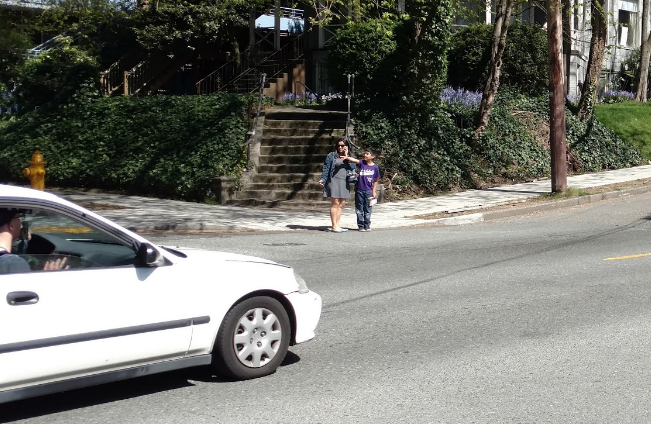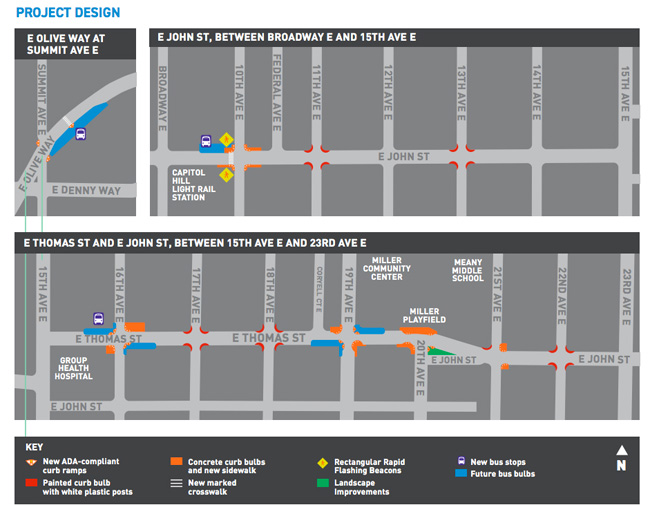Walking to Transit on Capitol Hill
- gordon
- Nov. 27, 2017
 In 2016, we proposed installing curb bulbs at the unsignalized intersections along the corridor in order to reduce crossing distances, improve visibility for people attempting to cross, and lower vehicle speeds. We won funding for these improvements when the Levy to Move Seattle Oversight Committee selected this project through SDOT’s Neighborhood Street Fund (NSF) program, noting that the corridor had the highest collision rate of all the projects being considered. The NSF program operates on a three year cycle. Projects were selected in 2016, continue through the design process in 2017, and will be constructed in 2018.
Working collaboratively with SDOT, we arrived at a design that fit within the $1 million scope of NSF project while still providing safety improvements at every unsignalized intersection along the one mile corridor from Broadway to 23rd Ave E. In general, the design provides concrete curb bulbs at all four corners of every intersection that includes a bus stop, while using less expensive flex-posts and paint to create curb bulbs at the other intersections. Early in the process, a separate Neighborhood Park & Street Fund project was folded into the design to include a flashing crosswalk beacon at E John St & 10th Ave E.
In 2016, we proposed installing curb bulbs at the unsignalized intersections along the corridor in order to reduce crossing distances, improve visibility for people attempting to cross, and lower vehicle speeds. We won funding for these improvements when the Levy to Move Seattle Oversight Committee selected this project through SDOT’s Neighborhood Street Fund (NSF) program, noting that the corridor had the highest collision rate of all the projects being considered. The NSF program operates on a three year cycle. Projects were selected in 2016, continue through the design process in 2017, and will be constructed in 2018.
Working collaboratively with SDOT, we arrived at a design that fit within the $1 million scope of NSF project while still providing safety improvements at every unsignalized intersection along the one mile corridor from Broadway to 23rd Ave E. In general, the design provides concrete curb bulbs at all four corners of every intersection that includes a bus stop, while using less expensive flex-posts and paint to create curb bulbs at the other intersections. Early in the process, a separate Neighborhood Park & Street Fund project was folded into the design to include a flashing crosswalk beacon at E John St & 10th Ave E.
 SDOT also coordinated with King County Metro, which was planning improvements in the corridor for route 8. Metro joined the project as a funding partner, increasing the scope of the project to relocate the westbound bus stop at Broadway to be nearer the light rail station entrance and adding large bus bulbs at E Olive Way & Summit Ave E, E John St & 10th Ave E, and E Thomas St at 16th Ave E and 19th Ave E. As the design process continues, the team is hopeful that there will be sufficient funding to include concrete curb bulbs at E Thomas St & 18th Ave E, proposed as a crossing for the future Central Ridge Neighborhood Greenway.
Most recently, SDOT announced that they’ll be installing a left-turn signal at the busy intersections of E Olive Way / E John St & Broadway E. This is a fantastic development that will help make this dangerous and confusing intersection a safer place for people walking, biking, taking transit, or driving, and supports the 2017 SNG priority for District 3, addressing some of the difficulties that Central Seattle Greenways identified in our 2016 audit of the station area.
We look forward to continuing to work with SDOT as the design for this corridor is finalized and construction begins next year.
If you value our work, please donate to keep us going.
SDOT also coordinated with King County Metro, which was planning improvements in the corridor for route 8. Metro joined the project as a funding partner, increasing the scope of the project to relocate the westbound bus stop at Broadway to be nearer the light rail station entrance and adding large bus bulbs at E Olive Way & Summit Ave E, E John St & 10th Ave E, and E Thomas St at 16th Ave E and 19th Ave E. As the design process continues, the team is hopeful that there will be sufficient funding to include concrete curb bulbs at E Thomas St & 18th Ave E, proposed as a crossing for the future Central Ridge Neighborhood Greenway.
Most recently, SDOT announced that they’ll be installing a left-turn signal at the busy intersections of E Olive Way / E John St & Broadway E. This is a fantastic development that will help make this dangerous and confusing intersection a safer place for people walking, biking, taking transit, or driving, and supports the 2017 SNG priority for District 3, addressing some of the difficulties that Central Seattle Greenways identified in our 2016 audit of the station area.
We look forward to continuing to work with SDOT as the design for this corridor is finalized and construction begins next year.
If you value our work, please donate to keep us going.